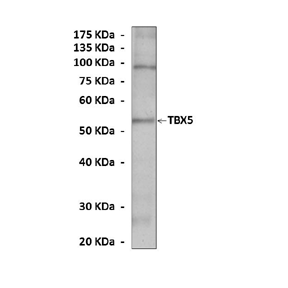Product Sheet CP10265
Description
BACKGROUND TBX5 is a T-box transcription factor belonging to the T-box gene family, the members of which share a highly conserved 180-aminoacid domain required for DNA binding. TBX5 has been characterized in most vertebrate lineages and is widely expressed during the development of various embryonic structures, including the heart, the eyes and the anterior set of paired appendages (tetrapod forelimbs and fish pectoral fins). Mutations in TBX5 cause Holt–Oram syndrome, an autosomal dominant human “heart-hand” condition characterized by upper limb and heart malformations. During embryogenesis TBX5 localizes to cellular nuclei. The protein transport is mediated by two distinct, evolutionary conserved nuclear localization signals (NLS) acting cooperatively. Missense mutations within these conserved sequences impair nuclear localization and cause "functional" haploinsufficiency due to decreased protein concentration at the location of its biological function. Heart formation requires a highly balanced network of transcriptional activation of genes. TBX5 is known to interact with the homeodomain protein NKX2.5 and the zinc finger protein GATA4 to coactivate the ANF gene and promote cardiomyocyte differentiation. Moreover, Stat3 is required for the differentiation of cardiomyocytes through direct transcriptional regulation of TBX5, NKX2.5, and GATA4.1 The homeodomain transcription factor, Shox2, is essential for the formation of the sinoatrial valves and for the development of the pacemaking system. It was shown that TBX5 is a regulator of Shox2 expression in the inflow tract and that Bmp4 is regulated by Shox2 in this compartment of the embryonic heart. In addition, it was also shown that Tbx5 acts cooperatively with NKX2.5 to regulate the expression of Shox2 and Bmp4. Thus, there is a link between TBX5, Shox2 and Bmp4 in the pacemaker region of the developing heart, which mediated the intricate interplay between the heart-specific transcriptional machinery and developmental signaling pathways.2 TBX5 also associates with TBX20, TAZ, SALL4, and LMP4. Recent studies have shown that the functional cooperation of TBX5 and NKX2.5 on the Id2 promoter is important for the development of the cardiac conduction system. It was shown that a physical interaction between TBX5 and MEF2C leads to a synergistic activation of the alpha-cardiac myosin heavy chain (MYH6). Studies suggest that the genetic interaction of these proteins is not only required for MYH6 expression but also essential for the early stages of heart development and survival.3 In addition, it was demonstrated that TBX5 regulates ventricular myocyte relaxation in a cell-autonomous manner by direct modulation of the expression of SERCA2a. Patients with HOS also have diastolic defects that resemble restrictive cardiomyopathy. This defines a TBX5-dependent pathway for the transcriptional control of diastolic function, with potential implications for the pathogenesis of heart failure and the management of altered heart function in patients with congenital heart defects (CHDs).4 Interestingly, it was reported that TBX5 can form a complex with splicing factor SC35 and plays an important role in constitutive pre-mRNA splicing, alternative splicing, and transcriptional activation. We further show that TBX5-associated splicing is relevant to the pathogenesis of Holt-Oram syndrome.5
REFERENCES
1. Snyder, M. et al: J. Biol. Chem. 285:23639-46, 2010
2. Puskaric, S. et al: Hum. Mol. Genet. 19:4625-3, 2010
3. Ghosh, T.K. et al: Mol. Cell. Biol. 29:2205-18, 2009
4. Zhu, Y. et al: proc. Natl. Acad. Sci. USA 105:5519-24, 2008
5. Fan, C. et al: J. Biol. Chem. 284:25653-63, 2009
2. Puskaric, S. et al: Hum. Mol. Genet. 19:4625-3, 2010
3. Ghosh, T.K. et al: Mol. Cell. Biol. 29:2205-18, 2009
4. Zhu, Y. et al: proc. Natl. Acad. Sci. USA 105:5519-24, 2008
5. Fan, C. et al: J. Biol. Chem. 284:25653-63, 2009
Products are for research use only. They are not intended for human, animal, or diagnostic applications.
Details
Cat.No.: | CP10265 |
Antigen: | Purified recombinant human TBX5fragments expressed in E. coli. |
Isotype: | Mouse IgG2b |
Species & predicted species cross- reactivity ( ): | Human, Mouse, Rat |
Applications & Suggested starting dilutions:* | WB 1:1000 IP n/d IHC n/d ICC n/d FACS n/d |
Predicted Molecular Weight of protein: | 53 kDa |
Specificity/Sensitivity: | Detects TBX5 proteins without cross-reactivity with other related proteins. |
Storage: | Store at -20°C, 4°C for frequent use. Avoid repeated freeze-thaw cycles. |
*Optimal working dilutions must be determined by end user.
Products
| Product | Size | CAT.# | Price | Quantity |
|---|---|---|---|---|
| Mouse TBX5 Antibody: Mouse TBX5 Antibody | Size: 100 ul | CAT.#: CP10265 | Price: $413.00 |

